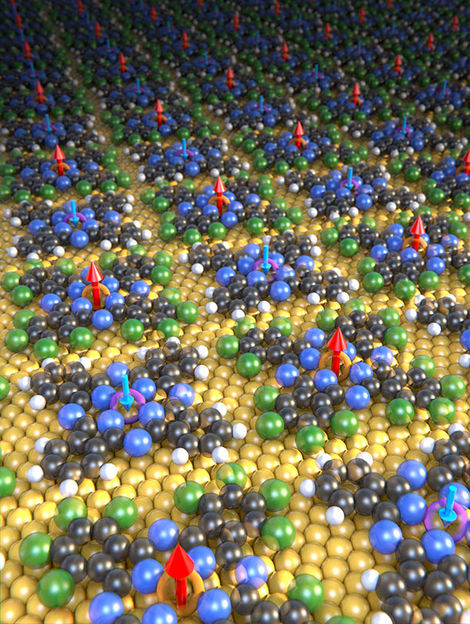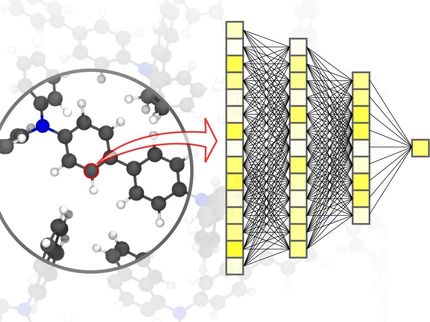Wafer-thin Magnetic Materials Developed for Future Quantum Technologies
Two-dimensional magnetic structures are regarded as a promising material for new types of data storage, since the magnetic properties of individual molecular building blocks can be investigated and modified. For the first time, researchers have now produced a wafer-thin ferrimagnet, in which molecules with different magnetic centers arrange themselves on a gold surface to form a checkerboard pattern.

Phthalocyanines with iron (orange) and manganese (violet) centers co-assemble on a gold surface into a checkerboard pattern. The magnetism of iron and manganese differs in strength and points in opposite directions (red and blue arrows), fulfilling the prerequisites for extremely, atomically thin ferrimagnets.
University of Basel, Department of Physics
Ferrimagnets are composed of two centers which are magnetized at different strengths and point in opposing directions. Two-dimensional, quasi-flat ferrimagnets would be suitable for use as sensors, data storage devices or in a quantum computer, since the two-dimensional arrangement allows the magnification state of the individual atoms or molecules to be selected. For mathematical and geometrical reasons, however, it has so far not been possible to produce two-dimensional ferrimagnets.
Choice of materials makes the impossible possible
The scientists in Professor Thomas Jung’s research groups at the Paul Scherrer Institute (PSI) and the Department of Physics at the University of Basel have now found a method of making a two-dimensional ferrimagnet.
The researchers first produce “phthalocyanines” – hydrocarbon compounds with different magnetic centers composed of iron and manganese. When these phthalocyanines are applied to a gold surface, they arrange themselves into a checkerboard pattern in which molecules with iron and manganese centers alternate. The researchers were able to prove that the surface is magnetic, and that the magnetism of the iron and manganese is of different strengths and appears in opposing directions – all characteristics of a ferrimagnet.
“The decisive factor of this discovery is the electrically conductive gold substrate, which mediates the magnetic order,” explains Dr. Jan Girovsky from the PSI, lead author of the study. “Without the gold substrate, the magnetic atoms would not sense each other and the material would not be magnetic.”
The decisive effect of the conducting electrons in the gold substrate is shown by a physical effect detected in each magnetic atom using scanning tunnel spectroscopy. The experiments were conducted at various temperatures and thus provide evidence of the strength of the magnetic coupling in the new magnetic material. Model calculations confirmed the experimentally observed effect and indicated that special electrons attached to the surface in the gold substrate are responsible for this type of magnetism.
Nanoarchitecture leads to new magnetic materials
“The work shows that a clever combination of materials and a particular nanoarchitecture can be used to produce new materials that otherwise would be impossible,” says Professor Nirmalya Ballav of the Indian Institute of Science Education and Research in Pune (India), who has been studying the properties of molecular nano-checkerboard architectures for several years with Jung. The magnetic molecules have great potential for a number of applications, since their magnetism can be individually investigated and also modified using scanning tunnel spectroscopy.
Original publication
Jan Girovsky, Jan Nowakowski, Md. Ehesan Ali, Milos Baljozovic, Harald R. Rossmann, Thomas Nijs, Elise A. Aeby, Sylwia Nowakowska, Dorota Siewert, Gitika Srivastava, Christian Wackerlin, Jan Dreiser, Silvio Decurtins, Shi-Xia Liu, Peter M. Oppeneer, Thomas A. Jung and Nirmalya Ballav; "Long-range ferrimagnetic order in a two-dimensional supramolecular Kondo lattice"; Nature Communications; 2017
Other news from the department science
Most read news
More news from our other portals
See the theme worlds for related content
Topic World Spectroscopy
Investigation with spectroscopy gives us unique insights into the composition and structure of materials. From UV-Vis spectroscopy to infrared and Raman spectroscopy to fluorescence and atomic absorption spectroscopy, spectroscopy offers us a wide range of analytical techniques to precisely characterize substances. Immerse yourself in the fascinating world of spectroscopy!

Topic World Spectroscopy
Investigation with spectroscopy gives us unique insights into the composition and structure of materials. From UV-Vis spectroscopy to infrared and Raman spectroscopy to fluorescence and atomic absorption spectroscopy, spectroscopy offers us a wide range of analytical techniques to precisely characterize substances. Immerse yourself in the fascinating world of spectroscopy!




























































